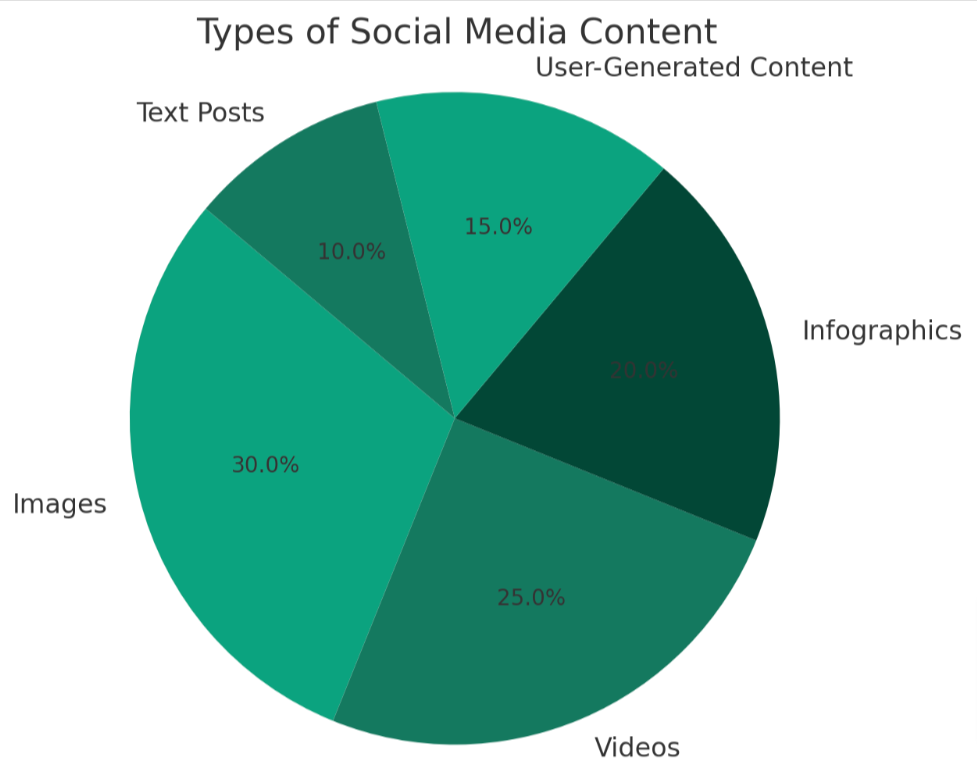Mastering the Art of Social Media Content Creation
Creating great social media content can be tough. Every day, millions of posts flood the internet, competing for attention. Our blog will guide you through crafting irresistible posts that stand out in the crowded social media landscape.
Stay tuned – we’re about to make waves!
Key Takeaways
- Use a variety of content types like images, videos, infographics, and polls to keep social media posts fresh and engaging for different audience preferences.
- Set clear goals for your social media strategy and know your audience well to create posts that resonate with them and encourage sharing.
- Analyze competitors’ content strategies to identify what works and find opportunities to stand out in the crowded social media space.
- Building a content calendar helps plan ahead, ensuring consistent posting during peak times while adapting strategy based on performance data.
- Promote content across multiple channels, collaborate with influencers, measure results regularly, and adjust tactics for improved engagement.
What is Social Media Content Creation?
Social media content creation involves crafting and sharing material like images, videos, and blog posts on platforms such as Facebook, Twitter, and Instagram. This process aims to capture attention, engage with followers, and encourage sharing among users.
Every tweet sent out or story posted is part of a larger content strategy designed to boost online engagement and strengthen digital presence.
Successful social media management requires producing valuable social media content that resonates with your audience. It’s not just about posting frequently; it’s about ensuring each piece of content aligns with your brand’s goals and appeals directly to the interests of your viewers.
From creating eye-catching infographics for social media to leveraging AI for fresh ideas or repurposing existing digital content in new ways – every action taken contributes significantly towards achieving a robust online branding through effective content marketing.
The Importance of a Social Media Strategy
Identifying goals, understanding your audience, and analyzing competitors are crucial steps in creating a successful social media strategy. By building a content calendar and promoting/distributing content effectively, you can ensure that your social media presence is consistent and engaging.
Identifying goals
To kick off a solid social media strategy, you must set clear and achievable goals. Think about what you want your online content to accomplish. Are you aiming to drive more traffic to your website, boost product sales, increase brand awareness, or engage with customers more effectively? Setting these objectives is crucial because they guide every piece of content you create and share on social media platforms.
Goals act as benchmarks for measuring success and help prioritize tasks. For example, if engaging content is your aim, focus on crafting posts that spark conversations and encourage user-generated content.
Once the end targets are in place, it’s easier to decide who your audience should be – which is where knowing your target demographic comes into play.
Knowing your audience
Understanding who is following you on social media shapes everything from the tone of your messages to the type of content you share. Different audiences have unique preferences and habits; by tapping into these, you can create engaging content that resonates.
For instance, younger demographics might gravitate towards quick, fun videos on platforms like TikTok, while a professional crowd may seek out detailed articles or infographics on LinkedIn.
Crafting content that appeals directly to your audience requires insight into their interests, needs, and online behavior. Use analytics tools to dive deep into demographics such as age ranges, locations, and peak activity times.
Engage with them through polls or direct conversations to gather feedback about what they enjoy most about your social media presence. Tailor every post with this intel in mind – an informed strategy ensures higher levels of user-generated content and digital engagement.
Analyzing competitors
Analyzing competitors is a crucial step in creating effective social media content. Examining the type of content your competitors are producing can provide valuable insights into what resonates with your target audience.
By understanding their strategies, you can identify opportunities to differentiate and improve your own content.
Observing the tactics of your competition enables you to stay ahead in the rapidly evolving landscape of social media. This analysis helps refine your approach, ensuring that your content stands out and captivates your audience for enhanced engagement and brand visibility.
Auditing current content
To ensure a cohesive and effective social media strategy, it is essential to move beyond competitor analysis and delve into auditing current content. This involves reviewing the existing content across various social media platforms, assessing its performance, relevance to the target audience, and alignment with your brand’s goals.
By conducting a thorough audit of current content, you can identify areas for improvement, determine what types of posts resonate most with your audience, and refine your future content strategy accordingly.
The process of auditing current content also enables you to identify gaps in your content calendar or potential opportunities for repurposing existing material. Additionally, analyzing past data allows you to make informed decisions about the type of user-generated content that has performed well in the past and integrate it into your future social media strategy.
Choosing content types
When creating content for social media, it’s important to carefully consider the types of content that will engage your audience. This can include a variety of formats to keep your content fresh and appealing.
- Images: High-quality photos and graphics can attract attention and convey messages effectively.
- Videos: Engaging videos can tell stories, demonstrate products, or entertain audiences.
- Infographics: Visual representations of information are easily shareable and highly engaging.
- GIFs: Animated images can add humor or visual interest to your content.
- User-generated content: Encouraging users to create and share their own content can build community and authenticity.
- Polls and surveys: Interactive content that invites audience participation and generates valuable insights.
- How-to guides: Providing valuable information in a step-by-step format can position your brand as an authority in your industry.
Building a content calendar
To build a content calendar, follow these steps:
- Research peak times for posting on different platforms to optimize reach and engagement.
- Identify key dates, events, and holidays that are relevant to your audience and your brand.
- Plan content themes or campaigns around these dates for cohesive messaging.
- Allocate specific types of content to different days based on your audience’s preferences and behavior.
- Use scheduling tools to organize and manage posts across various platforms efficiently.
- Collaborate with team members or stakeholders to input suggestions and ensure alignment with overall strategy.
- Set aside time for regular review and adjustment of the content calendar based on analytics and performance data.
Promoting and distributing content
To increase the visibility of your content, you can promote and distribute it effectively. Here are some strategies to consider:
- Collaborate with industry partners.
- Utilize paid advertising on social media platforms.
- Engage with your audience through comments and messages.
- Utilize email marketing to share your content.
- Share user – generated content to build community engagement.
- Leverage hashtags on various platforms to reach a broader audience.
- Cross – promote content across different social media channels.
- Partner with influencers to amplify your content’s reach.
- Utilize SEO strategies to make your content more discoverable online.
Tips for Creating Effective Social Media Content
Attend conferences, stay updated, and utilize eye-catching infographics to create engaging content. Incorporate video content, collaborate with influencers, run contests, use emotional images and write engaging captions to capture your audience’s attention.
Attend conferences and stay updated
Participate in industry conferences and continuously update your knowledge about social media trends. By attending these events, you can gain insights into the latest content creation techniques and strategies.
Staying updated through conferences helps you stay ahead of new platform features, algorithm changes, and emerging content formats, enabling you to adapt your approach to creating engaging social media content that resonates with your audience.
Networking at conferences also provides opportunities to connect with like-minded professionals, share experiences, and gather valuable tips for enhancing your social media content strategy.
Keep abreast of the latest developments in social media by attending relevant industry gatherings where experts discuss cutting-edge approaches to user-generated content, AI-driven content creation tools, video production for social media platforms, and effective ways to repurpose existing digital material.
Utilize eye-catching infographics
Staying updated by attending conferences gives you valuable insights, and when it comes to creating engaging social media content, infographics can be a game-changer. Visual elements like infographics are eye-catching and make complex information easy to understand.
They are highly shareable and have the potential to go viral, increasing your brand’s visibility and reach. Utilizing infographics in your social media content strategy can effectively convey data-driven insights, statistics, or step-by-step processes while keeping your audience engaged.
Infographics are versatile assets that can be repurposed across various platforms such as Instagram, Twitter, Facebook, and LinkedIn. Integrating visually appealing infographics into your content mix not only adds variety but also enhances the overall quality of your online presence.
Incorporate video content
Creating engaging social media content is crucial for establishing a strong online presence. When incorporating video content, remember to keep it concise and visually captivating to grab the audience’s attention.
Utilize trending hashtags and add captions or subtitles for accessibility. Collaborating with influencers for video content can significantly boost exposure and engagement, helping to promote your brand effectively.
Video creation for social media should align with your overall content strategy, conveying a clear message that resonates with your target audience. Analyzing results from video posts will provide valuable insights into what type of content performs best on different platforms.
Collaborate with influencers
Partner with influencers within your niche to expand your reach and grow your audience. Identify influencers whose values align with yours, ensuring that their followers are part of your target demographic.
Engage in meaningful collaborations that showcase authentic interactions rather than sales pitches. Leveraging the trust and authority that influencers have established can significantly boost engagement and brand awareness across various social media platforms.
Influencer partnerships are a powerful way to establish credibility, increase exposure, and drive traffic to your content. By harnessing the reach of influential individuals, you can effectively amplify your message and connect with potential customers on a more personal level.
Run contests
Engage your audience by running contests that encourage participation and interaction. Encourage users to share their experiences, create user-generated content, and spread the word about your brand.
Organize fun and exciting giveaways or competitions that resonate with your target audience, driving engagement and fostering a sense of community around your brand. Additionally, leverage social media platforms’ built-in features like polls and quizzes to boost interactions further.
– Use emotional images
Use emotional images
After running contests to engage your audience, another effective way to create compelling social media content is by using emotional images. Emotional imagery can evoke strong feelings and connections with your audience, making your content more engaging and shareable.
Whether it’s happiness, sadness, excitement, or nostalgia, emotional images have the power to resonate with people on a deeper level than just text or ordinary visuals.
When incorporating emotional images into your social media content, consider how you want your audience to feel and what action you want them to take. Utilize captivating visuals that align with your brand and messaging while tapping into emotions that will drive meaningful interactions and responses from your followers.
Write engaging captions
Crafting engaging captions is key to capturing your audience’s attention on social media. Use compelling language and storytelling that resonates with your followers to make them stop scrolling and engage with your content.
Incorporate relevant keywords and hashtags that align with your brand and the interests of your target audience, making it easier for users to find and connect with your posts. Keep your captions concise while still delivering value or evoking emotion, prompting users to take action or share their thoughts in the comments section.
Make use of emojis and spacing creatively within captions to break up text and make it more visually appealing. Encourage interaction by asking questions or inviting users to tag a friend who would appreciate the post.
Plan content in advance
When crafting engaging captions, it’s crucial to plan your content in advance. This preparation allows for consistency and strategic timing, ensuring that your audience receives a steady flow of valuable social media content.
By planning ahead, you can align your posts with important dates, trends, and events relevant to your brand, maximizing impact and engagement. Additionally, advanced planning provides flexibility to adjust strategies based on ongoing performance analysis.
Utilizing a detailed content calendar assists in organizing and scheduling posts across various platforms. It also enables the team to collaborate effectively while maintaining an overarching theme or message throughout all materials.

Utilize Facebook groups
Join relevant Facebook groups to reach your target audience and foster engagement. Actively participate by sharing valuable content, answering questions, and joining discussions. Leverage these communities to gather insights about popular topics, trends in your industry, and the needs of your potential customers.
Engaging with members can provide opportunities for collaboration, networking, and even user-generated content ideas that align with their interests and preferences. By continually adding value to these groups, you can establish trust, credibility, and expand your online presence.
Engage actively in Facebook groups aligned with your industry or niche to build connections with potential clients or partners while gaining valuable insights into market trends from like-minded individuals.
Measure and analyze results
To ensure your social media content is effective, it’s crucial to measure and analyze the results. Here are some key actions to take:
- Track engagement metrics such as likes, shares, comments, and clicks.
- Monitor your follower growth and identify any spikes or drops in numbers.
- Analyze the performance of different content types to understand what resonates with your audience.
- Use social media analytics tools to gain insights into your audience demographics and behaviors.
- A/B test different elements of your content to optimize performance.
- Identify trends and patterns in the data that can inform future content strategies.
- Compare your performance against industry benchmarks to gauge success.
- Adjust your content strategy based on the findings from your analysis.
Conclusion
In conclusion, creating effective online content for social media requires a well-planned strategy. Utilizing eye-catching visuals and engaging captions can captivate your audience’s attention.
Collaborating with influencers and analyzing the results are key components in achieving successful social media content. Planning in advance and staying updated on the latest trends will help you stay ahead in this ever-evolving digital landscape.

